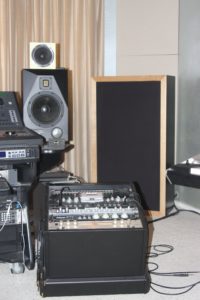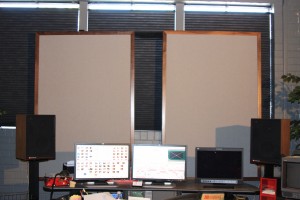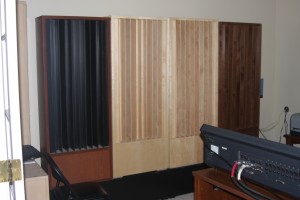Recording studio acoustic treatment falls into two major categories. We have sound absorption and sound diffusion technologies. Sound diffusion can be broken down into three sub categories: low, middle, and high frequency absorption. Sound diffusion is its own category but must not be confused with sound redirection. Lets exam low frequency absorption technology first.
Recording studio acoustic treatment
Low Frequency Absorbers
Low frequency absorbers can be freestanding or built into a recording studio. If the studio is built new from the ground up, low frequency absorbers can be built into the structure in the places that they need to be placed to absorb unwanted low frequency energy. Two main types of absorbers used in this manner are slatted and membrane absorbers.
Slatted Absorbers
Slatted absorbers have slats or openings that allow the low frequency energy to enter and then be absorbed into the inside of the slatted chamber. Slatted absorbers are really another name for Helmholtz resonators. Air enters through the openings and resonates inside the slatted chamber which is designed with a certain depth and cabinet fill to absorb the problematic low frequencies the studio designer is working on. A coke bottle is a classic example of a Helmholtz resonator. It resonates around 185 Hz. Frequencies above 185 Hz. are absorbed.
Membrane Absorbers
Membrane absorbers or diaphragmatic absorbers are the second main category of low frequency absorbers. With a diaphragmatic absorber, we have a diaphragm or front wall that vibrates when low frequency energy strikes it. This vibrating front wall slows down the long, low frequency wave before it enters the inside cabinet dimensions. Inside the cabinet is sound absorbing material to assist in absorption of the low frequency energy entering it. Diaphragmatic absorbers can be designed to absorb a large amount of energy in a small amount of space.
Acoustic Foams
Middle and high frequency absorption is well known in the recording studio acoustic treatment genre. Acoustic foams receive the most attention. Acoustic foams, more specifically, open celled acoustic foams, absorb middle and high frequency energy by converting sound energy to heat. Sound energy enters each open cell of the foam and is converted to heat. This energy transformation process results in energy conversion from mechanical energy into heat and this energy conversion process creates sound absorption. Acoustic foams are popular because they are lightweight and relatively inexpensive to manufacture.
Mineral Wool / Fiberglass
Middle and high frequency absorption can also be accomplished using fiberglass or building insulation type materials. Mineral wools also fall into this category. These materials are inexpensive to manufacture and are readily available. However, they are difficult to work with and do present some environmental issues when handling. Fibers from the material can break off the insulation and be inhaled. Proper air filtration methods must be employed when handling this material type to avoid any chance of inhaling the fibers.
Sound Diffusion
Diffusion can take many forms within the genre of recording studio acoustic treatment. We must define sound diffusion vs. sound redirection, so we are all on the same page. Sound diffusion takes sound energy and spreads it out into both horizontal and vertical planes. Sound redirection is just what the name indicates. A sound redirection device takes sound energy that strikes it and sends that energy off in an opposite direction of the angle of strike. Sound redirection and sound diffusion are frequently used as synonyms but they describe different processes.
Quadratic Diffusion
The most popular sound diffusion in use today is termed quadratic diffusion. Quadratic diffusors are built using a series of wells or troughs that have a specific width and a specific depth. The number of wells are determined using a prime number sequence. A prime number of 7 would have 6 wells of different depths, A prime number of 23 would have 22 depths. Each well depth diffuses energy at a quarter wavelength and well width is based on half wavelength. A vertically positioned quadratic diffusor will spread sound out in the horizontal plane. A horizontally positioned diffusor will spread sound out in a fan like array in the vertical dimension.
Sound Redirection
Sound redirection devices are different than quadratic diffusors. A common sound redirection device looks like half a circle with a 180 degree arc to it. Sound energy strikes the hemisphere and depending on the strike angle, will be redirected into the opposite direction. The physical law of angle of incident equals angle of refraction applies here. There is no spreading out of the sound in a fan like array which is the hallmark trait of quadratic diffusion. Sound is simply redirected from one direction into another.
Sound Absorption / Diffusion
Recording studio acoustic treatment comes in two basic types. We have sound absorption and sound diffusion technologies. Sound absorption is broken down into three sub groups: low, middle, and high frequency absorption. Low frequency energy is absorbed using slatted and membrane or diaphragmatic absorbers. Middle and high frequency absorption can be achieved using open celled acoustic foams. Sound diffusion is not to be confused with sound redirection. Quadratic diffusion is a time tested and proven method of diffusing sound energy into the vertical and horizontal dimensions.









Lovely Information! Thanks.